Adsorptive Removal of Azithromycin Antibiotic from Aqueous Solution by Azolla Filiculoides-Based Activated Porous Carbon
Abstract
1. Introduction
2. Materials and Methods
2.1. Materials
2.2. Preparation of Activated Porous Carbon from AF
2.3. Characterization of Activated Porous Carbon
2.4. Point of Zero Charges (pHpzc) Measurement
2.5. Batch Adsorption Study
3. Results and Discussions
3.1. Characteristic of AZM and Characterization of Adsorbent AFAC
3.2. Adsorption of AZM on AFAC
3.2.1. Effect of Temperature and Contact Time
3.2.2. Effect of Adsorbent Dose
3.2.3. Effect of pH
3.2.4. Adsorption Isotherms
3.2.5. Adsorption Kinetic
3.2.6. Adsorption Thermodynamics
4. Conclusions
Supplementary Materials
Author Contributions
Funding
Institutional Review Board Statement
Informed Consent Statement
Data Availability Statement
Acknowledgments
Conflicts of Interest
References
- Balarak, D.; Mostafapour, F.K. Photocatalytic Degradation of Amoxicillin Using UV/Synthesized NiO from Pharmaceutical Wastewater. Indones. J. Chem. 2019, 19, 211. [Google Scholar] [CrossRef]
- Rostamian, R.; Behnejad, H. A comparative adsorption study of sulfamethoxazole onto graphene and graphene oxide nanosheets through equilibrium, kinetic and thermodynamic modeling. Process. Saf. Environ. Prot. 2016, 102, 20–29. [Google Scholar] [CrossRef]
- Huang, L.; Wang, M.; Shi, C.; Huang, J.; Zhang, B. Adsorption of tetracycline and ciprofloxacin on activated carbon prepared from lignin with H3PO4activation. Desalination Water Treat. 2014, 52, 2678–2687. [Google Scholar] [CrossRef]
- Li, M.; Shu, D.; Jiang, L. Cu (II)-influenced adsorption of ciprofloxacin from aqueous solutions by magnetic graphene ox-ide/nitrilotriacetic acid nanocomposite: Competition and enhancement mechanisms. Chem. Eng. J. 2017, 319, 219–228. [Google Scholar] [CrossRef]
- Balarak, D.; Azarpira, H.; Mostafapour, F.K. Study of the Adsorption Mechanisms of Cephalexin on to Azolla Filiculoides. Der. Pharm. Chem. 2016, 8, 114–121. [Google Scholar]
- Zhang, B.; Zhang, H.; Li, X.; Lei, X.; Li, C.; Yin, D.; Fan, X.; Zhang, Q. Synthesis of BSA/Fe3O4 magnetic composite microspheres for adsorption of antibiotics. Mater. Sci. Eng. C 2013, 33, 4401–4408. [Google Scholar] [CrossRef]
- Yazdani, A.; Sayadi, M.H. Sonochemical degradation of azithromycin in aqueous solution. Environ. Health Eng. Manag. J. 2018, 5, 85–92. [Google Scholar] [CrossRef]
- Homem, V.; Santos, L. Degradation and removal methods of antibiotics from aqueous matrices–A review. J. Environ. Manag. 2011, 92, 2304–2347. [Google Scholar] [CrossRef]
- Mandić, Z.; Weitner, Z.; Ilijaš, M. Electrochemical oxidation of azithromycin and its derivatives. J. Pharm. Biomed. Anal. 2003, 33, 647–654. [Google Scholar] [CrossRef]
- Yang, Z.Y.; Wang, L.; Tang, X. Determination of azithromycin by ion-pair HPLC with UV detection. J. Pharm. Biomed. Anal. 2009, 49, 811–815. [Google Scholar] [CrossRef]
- Kamranifar, M.; Allahresani, A.; NaghiZadeh, A. Application of CoFe2O4@CuS magnetic nanocomposite as a novel adsorbent for removal of Penicillin G from aqueous solutions: Isotherm, kinetic and thermodynamic study. Desalin. Water Treat. 2019, 148, 263–273. [Google Scholar] [CrossRef]
- Balarak, D.; Azarpira, H. Photocatalytic degradation of Sulfamethoxazole in water: Investigation of the effect of operational parameters. Int. J. ChemTech Res. 2016, 9, 731–738. [Google Scholar]
- Gao, J.; Pedersen, J.A. Adsorption of Sulfonamide Antimicrobial Agents to Clay Minerals. Environ. Sci. Technol. 2005, 39, 9509–9516. [Google Scholar] [CrossRef] [PubMed]
- Peterson, J.W.; Petrasky, L.J.; Seymourc, M.D.; Burkharta, R.S.; Schuilinga, A.B. Adsorption and breakdown of penicillin antibiotic in the presence of titanium oxide nanoparticles in water. Chemosphere 2012, 87, 911–917. [Google Scholar] [CrossRef] [PubMed]
- Aksu, Z.; Tunç, Ö. Application of biosorption for penicillin G removal: Comparison with activated carbon. Process. Biochem. 2005, 40, 831–847. [Google Scholar] [CrossRef]
- Putra, E.K.; Pranowoa, R.; Sunarsob, J.; Indraswatia, N.; Ismadjia, S. Performance of activated carbon and bentonite for adsorption of amoxicillin from wastewater: Mechanisms, isotherms and kinetics. Water Res. 2009, 43, 2419–2430. [Google Scholar] [CrossRef] [PubMed]
- Mahdi, W.A.; Hussain, A.; Bukhari, S.I.; Alshehri, S.; Singh, B.; Alic, N. Removal of clarithromycin from aqueous solution using wa-ter/triton X-100/ ethanol/ olive oil green nanoemulsion method. J. Water Proc. Eng. 2021, 40, 101973. [Google Scholar] [CrossRef]
- Hussain, A.; Afzal, O.; Altamimi, A.S.; Ali, R. Application of green nanoemulsion to treat contaminated water (bulk aqueous solution) with azithromycin. Environ. Sci. Pollut. Res. 2021, 24, 61696–61706. [Google Scholar] [CrossRef] [PubMed]
- Ahmadi, S.; Banach, A.; Mostafapour, F.K.; Balarak, D. Study survey of cupric oxide nanoparticles in removal efficiency of ciprofloxacin antibiotic from aqueous solution: Adsorption isotherm study. Desalin. Water Treat. 2017, 89, 297–303. [Google Scholar] [CrossRef]
- Meshkinain, A.; Davoud, B.; Nastaran, Y. Optimization of nickel oxide nanoparticle synthesis through the sol-gel method for adsorption of Penicillin G. Res. J. Chem. Environ. 2021, 25, 31–36. [Google Scholar]
- Mahvi, A.H.; Mostafapour, F.K. Biosorption of tetracycline from aqueous solution by azolla filiculoides: Equilibrium kinetic and thermodynamics studies. Fresen. Environ. Bull. 2018, 27, 5759–5767. [Google Scholar]
- Zazouli, M.A.; Mahdavi, Y.; Bazrafshan, E.; Balarak, D. Phytodegradation potential of bisphenolA from aqueous solution by Azolla Filiculoides. J. Environ. Heal. Sci. Eng. 2014, 12, 66. [Google Scholar] [CrossRef]
- Balarak, D.; Mahdavi, Y.; Bazrafshan, E.; Mahvi, A.H. Kinetic, isotherms and thermodynamic modeling for adsorption of acid blue 92 from aqueous solution by modified azolla filicoloides. Fresen. Environ. Bull. 2016, 25, 1321–1330. [Google Scholar]
- Diyanati, R.; Yazdani, J.; Belarak, D. EEffect of sorbitol on phenol removal rate by lemna minor. J. Maz. Uni. Med. Sci. 2013, 22, 58–65. [Google Scholar]
- Diyanati, R.A.; Yousefi, Z.; Cherati, J.Y. The ability of Azolla and lemna minor biomass for adsorption of phenol from aqueous solutions. J. Maz. Uni. Med. Sci. 2013, 23, 17–23. [Google Scholar]
- Dyanati, R.A.; Yousefi, Z.A.; Cherati, J.Y. Investigating phenol absorption from aqueous solution by dried azolla. J. Maz. Uni. Med. Sci. 2013, 22 (Suppl. S2), 13–20. [Google Scholar]
- Padmesh, T.; Vijayaraghavan, K.; Sekaran, G.; Velan, M. Application of Azolla rongpong on biosorption of acid red 88, acid green 3, acid orange 7 and acid blue 15 from synthetic solutions. Chem. Eng. J. 2006, 122, 55–63. [Google Scholar] [CrossRef]
- Tan, C.; Li, G.; Lu, X.Q.; Chen, Z.-L. Biosorption of Basic Orange using dried A. filiculoides. Ecol. Eng. 2010, 36, 1333–1340. [Google Scholar] [CrossRef]
- Padmesh, T.; Vijayaraghavan, K.; Sekaran, G.; Velan, M. Batch and column studies on biosorption of acid dyes on fresh. Water macro alga Azolla filiculoides. J. Hazard. Mater. 2005, 125, 121–129. [Google Scholar] [CrossRef]
- Zazouli, M.A.; Mahvi, A.H.; Dobaradaran, S.; Barafrashtehpour, M.; Mahdavi, Y. Adsorption of fluoride from aqueous solution by modified Azolla Filiculoides. Fluoride 2014, 47, 349–358. [Google Scholar]
- Khatibi, A.D.; Mahvi, A.H.; Mengelizadeh, N. Adsorption-desorption of tetracycline onto molecularly imprinted polymer: Isotherm, kinetics, and thermodynamics studies. Desal. Water Treat. 2021, 230, 240–251. [Google Scholar] [CrossRef]
- Adriano, W.; Veredas, V.; Santana, C.; Gonçalves, L. Adsorption of amoxicillin on chitosan beads: Kinetics, equilibrium and validation of finite bath models. Biochem. Eng. J. 2005, 27, 132–137. [Google Scholar] [CrossRef]
- Chang, P.-H.; Li, Z.; Jean, J.-S.; Jiang, W.-T.; Wang, C.-J.; Lin, K.-H. Adsorption of tetracycline on 2:1 layered non-swelling clay mineral illite. Appl. Clay Sci. 2012, 67–68, 158–163. [Google Scholar] [CrossRef]
- Mohammadi, A.S.; Sardar, M. The Removal of Penicillin G from Aqueous Solutions using Chestnut Shell Modified with H2SO4: Isotherm and Kinetic Study. J. Health Environ. 2012, 6, 497–508. [Google Scholar]
- Rahardjo, A.K.; Susanto, M.J.J.; Kurniawan, A.; Indraswati, N.; Ismadji, S. Modified Ponorogo bentonite for the removal of ampicillin from wastewater. J. Hazard. Mater. 2011, 190, 1001–1008. [Google Scholar] [CrossRef] [PubMed]
- Li, S.; Zhang, X.; Huang, Y. Zeolitic imidazolate framework-8 derived nanoporous carbon as an effective and recyclable adsorbent for removal of ciprofloxacin antibiotics from water. J. Hazard. Mater. 2017, 321, 711–719. [Google Scholar] [CrossRef] [PubMed]
- Yaghmaeian, K.; Moussavi, G.; Alahabadi, A. Removal of amoxicillin from contaminated water using NH 4 Cl-activated carbon: Continuous flow fixed-bed adsorption and catalytic ozonation regeneration. Chem. Eng. J. 2014, 236, 538–544. [Google Scholar] [CrossRef]
- Balarak, D.; Azarpira, H.; Mostafapour, F.K. Adsorption isotherm studies of tetracycline antibiotics from aqueous solutions by maize stalks as a cheap biosorbent. Int. J. Pharm. Technol. 2016, 8, 16664–16675. [Google Scholar]
- Zha, S.X.; Zhou, Y.; Jin, X.; Chen, Z. The removal of amoxicillin from wastewater using organobentonite. J. Environ. Manag. 2013, 129, 569–576. [Google Scholar] [CrossRef]
- Liu, W.; Xie, H.; Zhang, J.; Zhang, C. Sorption removal of cephalexin by HNO3 and H2O2 oxidized activated carbons. Sci. China Ser. B Chem. 2012, 55, 1959–1967. [Google Scholar] [CrossRef]
- Erşan, M.; Bağd, E. Investigation of kinetic and thermodynamic characteristics of removal of tetracycline with sponge like, tannin based cryogels. Coll. Surfaces B Biointerfaces 2013, 104, 75–82. [Google Scholar] [CrossRef]
- Liu, W.; Zhang, J.; Zhang, C.; Ren, L. Sorption of norfloxacin by lotus stalk-based activated carbon and iron-doped activated alu-mina: Mechanisms, isotherms and kinetics. Chem. Eng. J. 2011, 171, 431–438. [Google Scholar] [CrossRef]
- Wang, F.; Yang, B.; Wang, H.; Song, Q.; Tan, F.; Cao, Y. Removal of ciprofloxacin from aqueous solution by a magnetic chitosan grafted graphene oxide composite. J. Mol. Liq. 2016, 222, 188–194. [Google Scholar] [CrossRef]
- Kyzas, G.Z.; Bikiaris, D.N.; Seredych, M.; Bandosz, T.J.; Deliyanni, E.A. Removal of dorzolamide from biomedical wastewaters with adsorption onto graphite oxide/poly(acrylic acid) grafted chitosan nanocomposite. Bioresour. Technol. 2014, 152, 399–406. [Google Scholar] [CrossRef]
- Danalıoğlu, S.T.; Bayazit, S.; Kuyumcu, K.; Salam, M.A. Efficient removal of antibiotics by a novel magnetic adsorbent: Magnetic activated carbon/chitosan (MACC) nanocomposite. J. Mol. Liq. 2017, 240, 589–596. [Google Scholar] [CrossRef]
- Peng, X.; Hu, F.; Dai, H.; Xiong, Q. Study of the adsorption mechanism of ciprofloxacin antibiotics onto graphitic ordered meso-porous carbons. J. Taiwan Instit. Chem. Eng. 2016, 8, 472–481. [Google Scholar] [CrossRef]
- Balarak, D.; Baniasadi, M.; Lee, S.-M.; Shim, M.J. Ciprofloxacin adsorption onto Azolla filiculoides activated carbon from aqueous solutions. Desal. Water Treat. 2021, 218, 444–453. [Google Scholar] [CrossRef]
- Agarwal, S.; Sadegh, H.; Monajjemi, M.; Hamdy, A.S.; Ali, G.A.; Memar, A.O.; Shahryari-Ghoshekandi, R.; Tyagi, I.; Gupta, V.K. Efficient removal of toxic bromothymol blue and methylene blue from wastewater by polyvinyl alcohol. J. Mol. Liq. 2016, 218, 191–197. [Google Scholar] [CrossRef]
- Gupta, V.K.; Agarwal, S.; Sadegh, H.; Ali, G.; Bharti, A.K.; Makhlouf, A.S.H. Facile route synthesis of novel graphene oxide-β-cyclodextrin nanocomposite and its application as adsorbent for removal of toxic bisphenol A from the aqueous phase. J. Mol. Liq. 2017, 237, 466–472. [Google Scholar] [CrossRef]
- Habeeb, O.A.; Ramesh, K.; Gomaa, A.M.A.; Bin, R.; Yunus, M. Low-cost and eco-friendly activated carbon from modified palm kernel shell for hydrogen sulfide removal from wastewater: Adsorption and kinetic studies. Desal. Water Treat. 2017, 84, 205–214. [Google Scholar] [CrossRef]
- Omar, A.H.; Ramesh, K.; Gomaa, A.M.A.; Rosli, B.M.Y. Experimental design technique on removal of hydrogen sulfide using CaO-eggshells dispersed onto palm kernel shell activated carbon: Experiment, optimization, equilibrium and kinetic studies. J. Wuhan Univ. Technol. Sci. Ed. 2017, 32, 305–320. [Google Scholar] [CrossRef][Green Version]
- Habeeb, O.A.; Kanthasamy, R.; Gomaa, A.M.A. Isothermal modelling based experimental study of dissolved hydrogen sulfide ad-sorption from waste water using eggshell based activated carbon. Malay. J. Anal. Sci. 2017, 21, 334–345. [Google Scholar]
- Balarak, D.; Taheri, Z.; Shim, M.J.; Lee, S.-M.; Jeon, C. Adsorption kinetics and thermodynamics and equilibrium of ibuprofen from aqueous solutions by activated carbon prepared from Lemna minor. Desal. Water Treat. 2021, 215, 183–193. [Google Scholar] [CrossRef]
- Ding, R.; Zhang, P.; Seredych, M.; Bandosz, T.J. Removal of antibiotics from water using sewage sludge- and waste oil sludge-derived adsorbents. Water Res. 2012, 46, 4081–4090. [Google Scholar] [CrossRef]
- Bui, T.X.; Choi, H. Adsorptive removal of selected pharmaceuticals by mesoporous silica SBA-15. J. Hazard. Mater. 2009, 168, 602–608. [Google Scholar] [CrossRef] [PubMed]
- Moussavi, G.; Alahabadi, A.; Yaghmaeian, K.; Eskandari, M. Preparation, characterization and adsorption potential of the NH4Cl-induced activated carbon for the removal of amoxicillin antibiotic from water. Chem. Eng. J. 2013, 217, 119–128. [Google Scholar] [CrossRef]
- Guler, U.A.; Sarioglu, M. Removal of tetracycline from wastewater using pumice stone: Equilibrium, kinetic and thermodynamic studies. J. Environ. Health Sci. Eng. 2014, 12, 79–87. [Google Scholar] [CrossRef]
- Kerkez-Kuyumcu, Ö.; Bayazit, Ş.S.; Salam, M.A. Antibiotic amoxicillin removal from aqueous solution using magnetically modified graphene nanoplatelets. J. Ind. Eng. Chem. 2016, 36, 198–205. [Google Scholar] [CrossRef]
- Kim, S.H.; Shon, H.K.; Ngo, H.H. Adsorption characteristics of antibiotics trimethoprim on powdered and granular activated carbon. J. Ind. Eng. Chem. 2010, 16, 344–349. [Google Scholar] [CrossRef]
- Azarpira, H.; Mahdavi, Y.; Khaleghi, O. Thermodynamic Studies on the Removal of Metronidazole Antibiotic by Multi-Walled Carbon Nanotubes. Der Pharm. Lett. 2016, 8, 107–113. [Google Scholar]
- Yu, F.; Li, Y.; Han, S.; Ma, J. Adsorptive removal of antibiotics from aqueous solution using carbon Materials. Chemosphere 2016, 153, 365–385. [Google Scholar] [CrossRef]
- Gao, Y.; Li, Y.; Zhang, L.; Huang, H.; Hu, J.; Shah, S.M.; Su, X. Adsorption and removal of tetracycline antibiotics from aqueous solution by graphene oxide, J. Colloids Interface Sci. 2012, 368, 540–546. [Google Scholar] [CrossRef] [PubMed]
- Hu, D.; Wang, L. Adsorption of amoxicillin onto quaternized cellulose from flax noil: Kinetic, equilibrium and thermodynamic study. J. Taiwan Inst. Chem. Eng. 2016, 64, 227–234. [Google Scholar] [CrossRef]
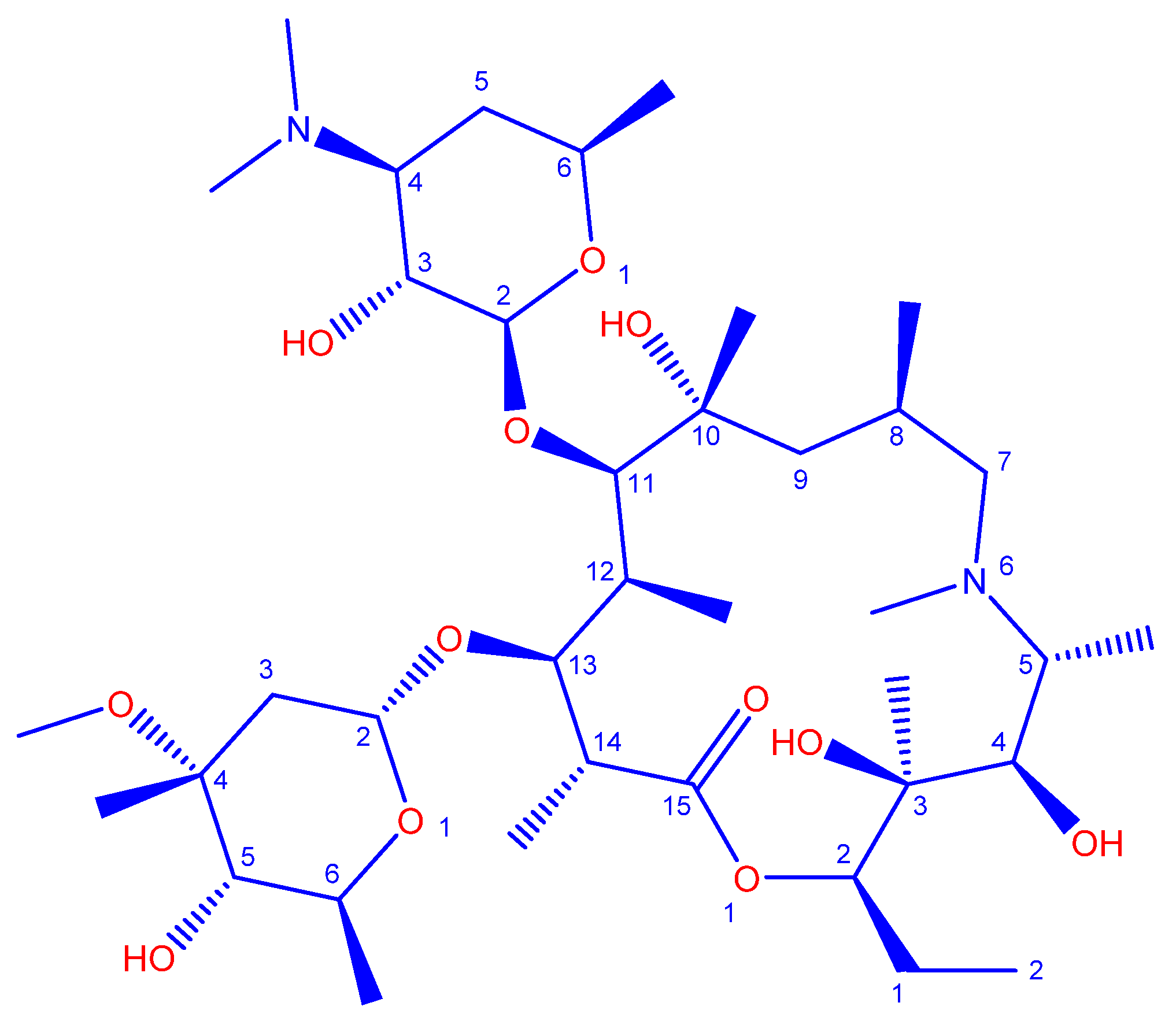
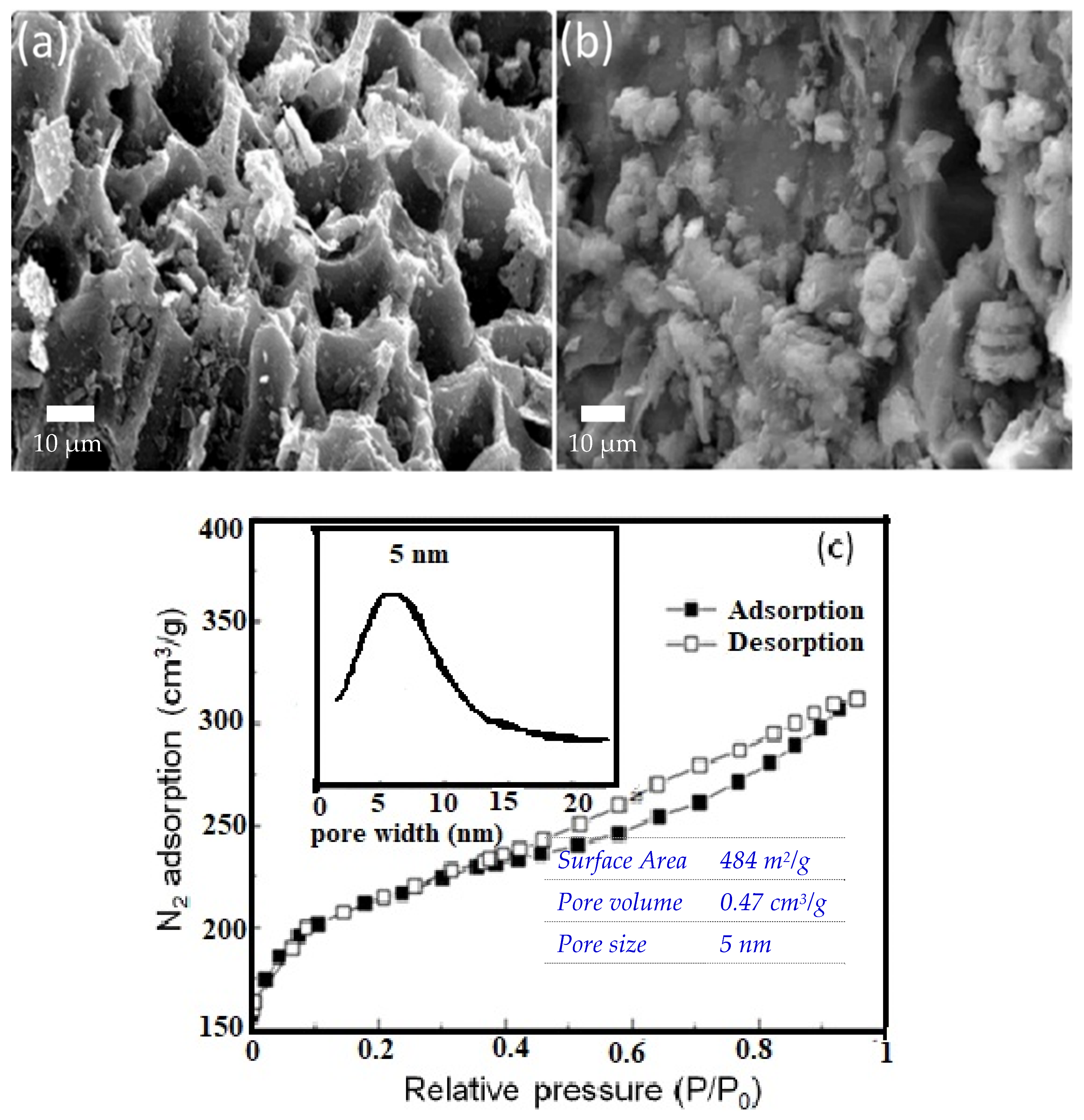
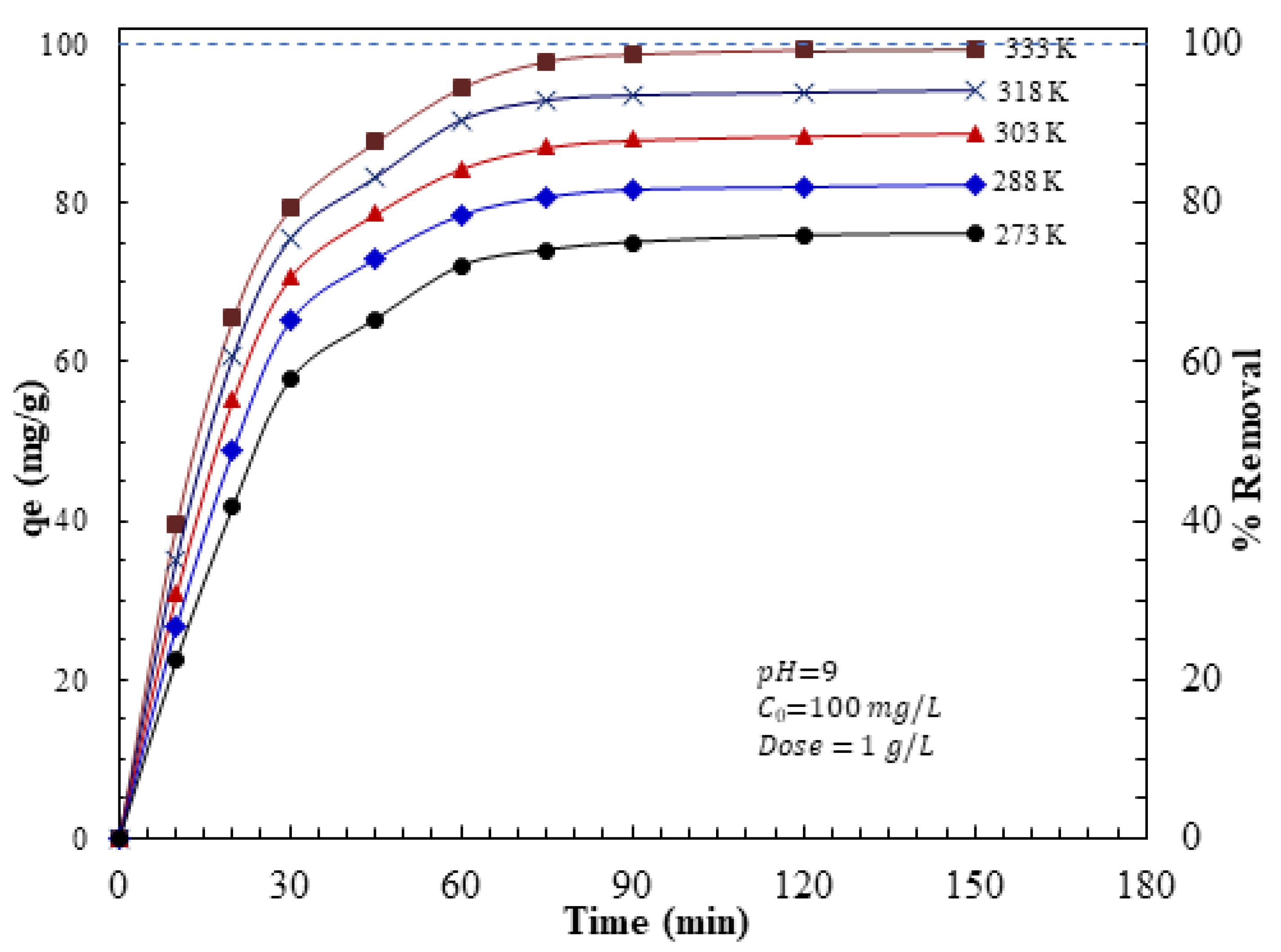
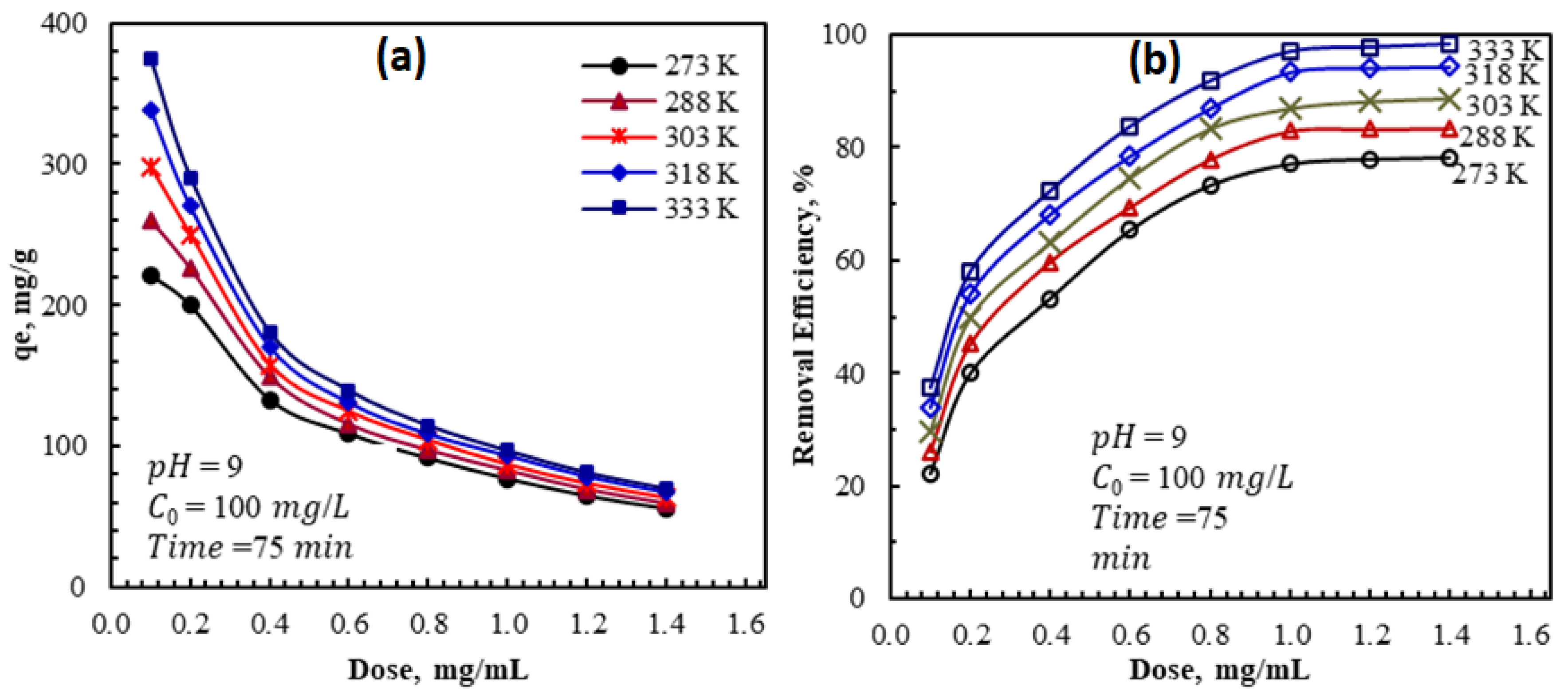
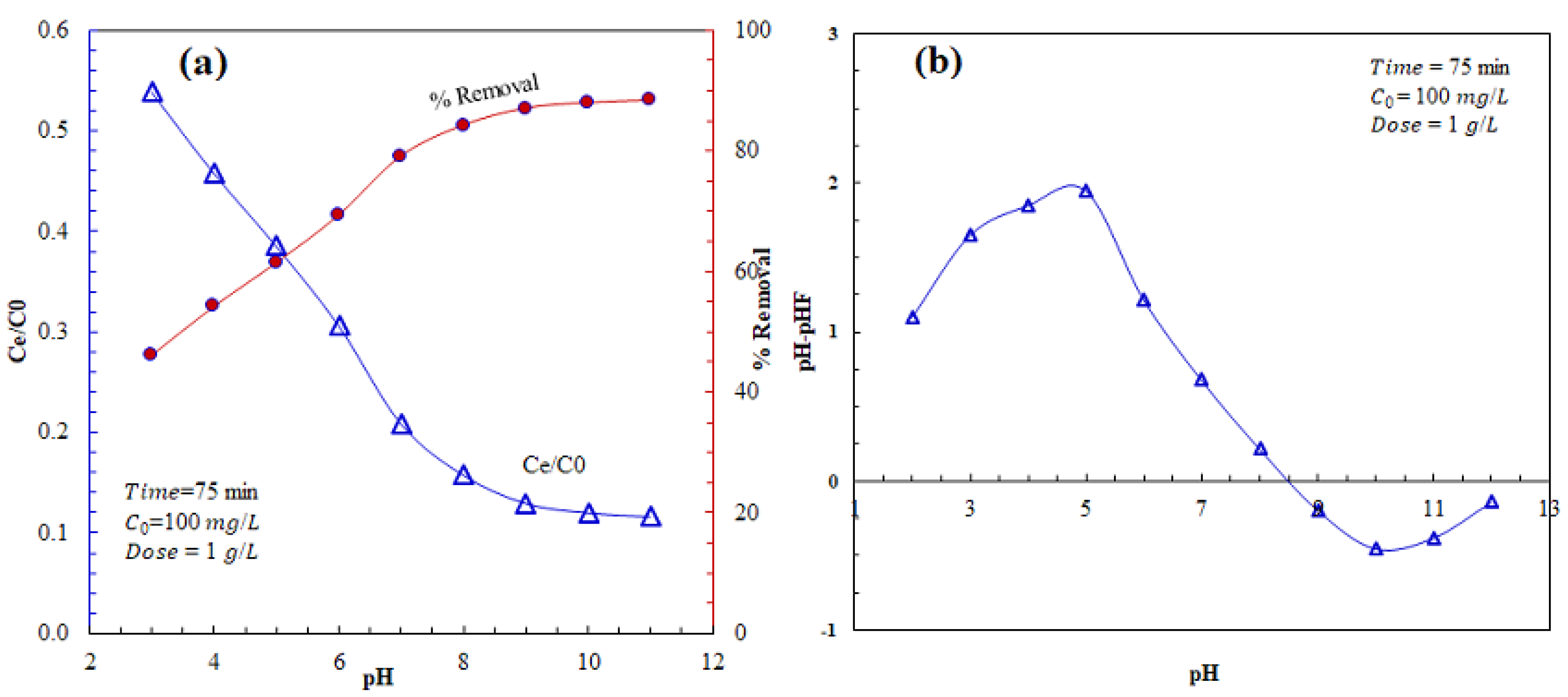

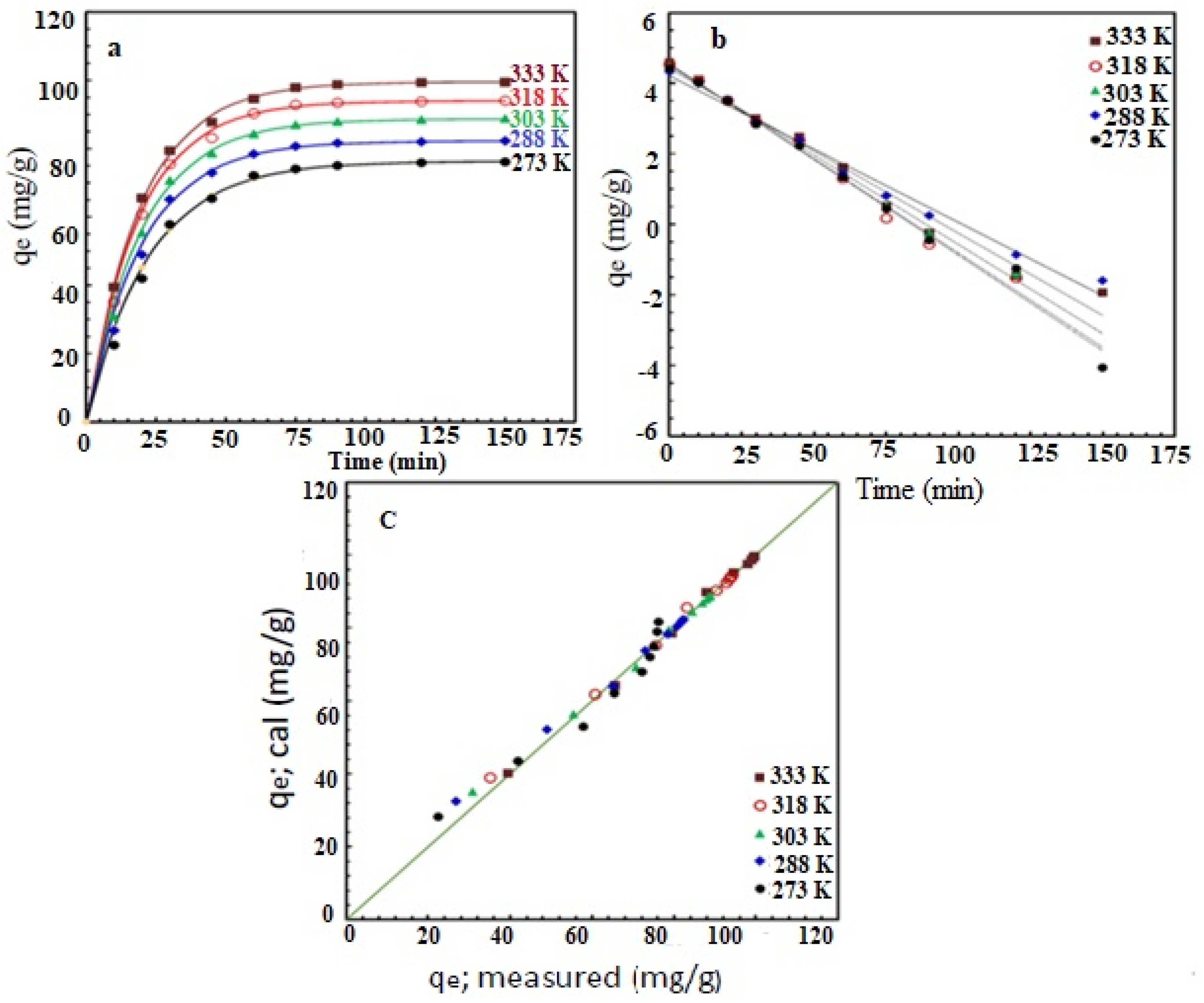
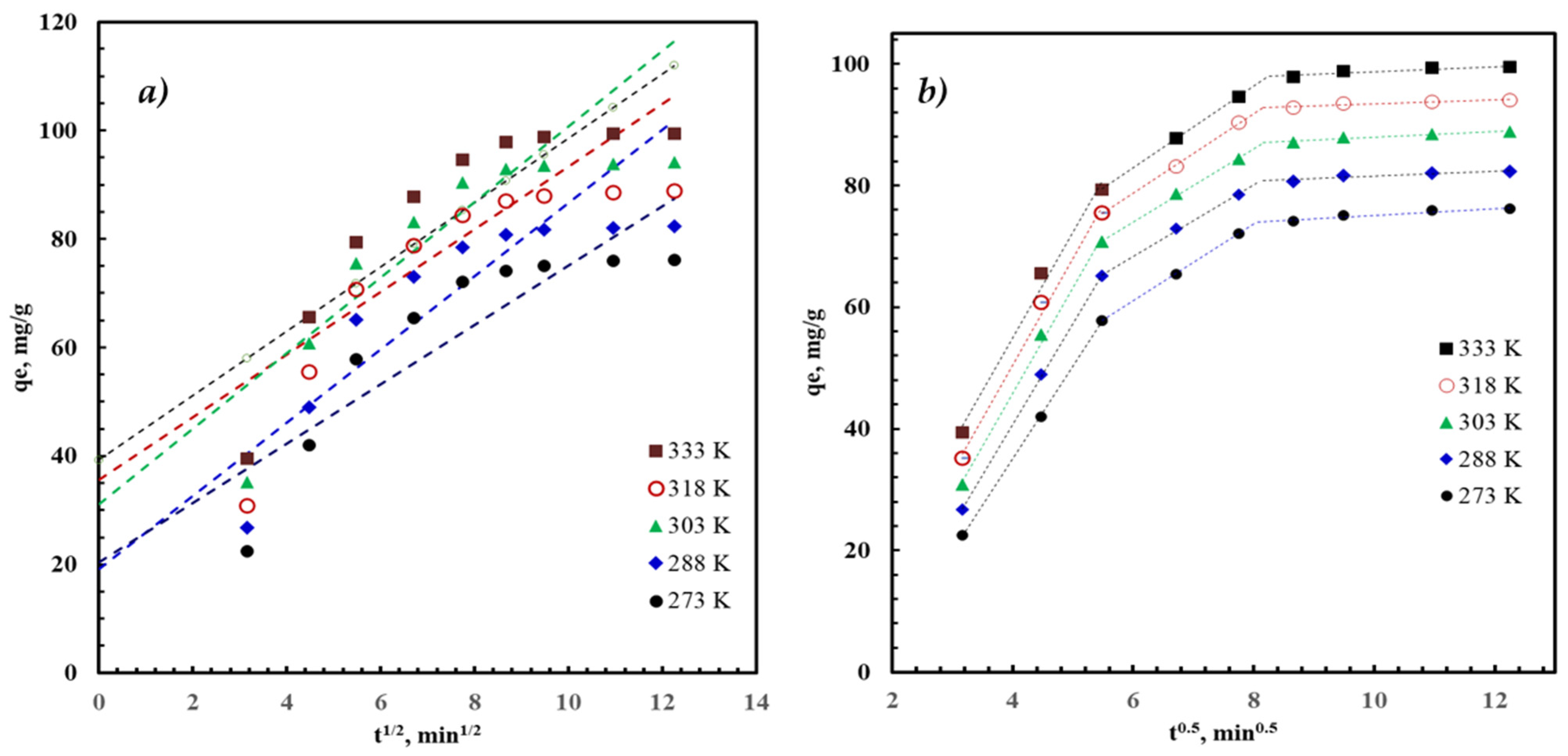
| Porosity, % | C% | %Moisture | Y | Density, g/cm3 | %H | Mg% | Fe% | K% | O% |
|---|---|---|---|---|---|---|---|---|---|
| 53.4 | 53.7 | 0.2 | 51.3 | 0.245 | 3.7 | 2.4 | 0.48 | 1.7 | 37.9 |
| T (K) | Freundlich | Langmuir | Temkin | D–R Model | |||||||||
|---|---|---|---|---|---|---|---|---|---|---|---|---|---|
| n | KF | R2 | qm | KL | RL | R2 | α | β | R2 | qm | R2 | ||
| 273 | 1.00 | 3.08 | 0.96 | 120.3 | 0.0003 | 0.98 | 0.712 | 0.08 | 123 | 0.92 | 212.1 | 1.2 × 10−4 | 0.93 |
| 288 | 1.10 | 5.43 | 0.97 | 159.7 | 0.0027 | 0.79 | 0.765 | 0.10 | 125 | 0.85 | 218.8 | 6.2 × 10−5 | 0.88 |
| 303 | 1.28 | 10.57 | 0.97 | 164.2 | 0.0085 | 0.54 | 0.781 | 0.15 | 118 | 0.83 | 221.7 | 2.8 × 10−5 | 0.86 |
| 318 | 1.72 | 26.11 | 0.95 | 196.1 | 0.0243 | 0.29 | 0.792 | 0.32 | 94 | 0.86 | 206.0 | 6.1 × 10−6 | 0.71 |
| 333 | 2.43 | 55.42 | 0.93 | 217.4 | 0.0588 | 0.15 | 0.793 | 1.12 | 70 | 0.81 | 197.0 | 7.1 × 10−7 | 0.60 |
| Antibiotics | Adsorbent | qe, max (mg/g) | Reference |
|---|---|---|---|
| Amoxicillin | Chitosan | 46.21 | [2] |
| Tetracycline | Illite | 78.12 | [11] |
| Penicillin | Chestnut Shell | 27.4 | [14] |
| Amoxicillin | AC | 56.81 | [16] |
| Tetracycline | maize stalks | 71.38 | [31] |
| SMZ | GO | 54.33 | [32] |
| Tetracycline | MWCNTS | 56.5 | [33] |
| Penicillin | TiO2 | 252.6 | [34] |
| Amoxicillin | Bentonite | 46.54 | [37] |
| Tetracycline | MIP | 38.9 | [38] |
| Cephalexin | AC | 43.5 | [40] |
| AZM | AFAC | 374 | This work |
| T (K) | Pseudo-First-Order | Pseudo-Second-Order | ||||
|---|---|---|---|---|---|---|
| k1 min−1 | qe mg/g | R2 | k2 (mg/g)−1min−1 | qe, mg/g | R2 | |
| 273 | 0.045 | 76.3 | 0.995 | 4.5 × 10−4 | 94.5 | 0.983 |
| 288 | 0.050 | 82.3 | 0.990 | 5.3 × 10−4 | 98.7 | 0.987 |
| 303 | 0.051 | 88.7 | 0.996 | 5.5 × 10−4 | 104.4 | 0.991 |
| 318 | 0.053 | 94.0 | 0.989 | 5.9 × 10−4 | 109.2 | 0.993 |
| 333 | 0.052 | 99.6 | 0.995 | 5.9 × 10−4 | 114.4 | 0.996 |
| T, (K) | Stage 1, (t < 30 min) | Stage 2, (30–60 min) | Stage 3, (t > 60 min) | ||||||
|---|---|---|---|---|---|---|---|---|---|
| kd1 | C | R2 | kd2 | C | R2 | kd3 | C | R2 | |
| 273 | 15.2 | −25.8 | 0.912 | 6.3 | 23.2 | 0.915 | 0.56 | 69.5 | 0.884 |
| 288 | 16.6 | −25.7 | 0.923 | 5.8 | 33.1 | 0.926 | 0.39 | 77.6 | 0.916 |
| 303 | 17.3 | −23.4 | 0.943 | 6 | 37.9 | 0.973 | 0.47 | 83.2 | 0.898 |
| 318 | 17.5 | −19.6 | 0.951 | 6.5 | 39.5 | 0.951 | 0.33 | 90.1 | 0.873 |
| 333 | 17.4 | −14.5 | 0.891 | 6.7 | 42.6 | 0.936 | 0.41 | 94.7 | 0.901 |
| T, (K) | ΔG°, (kJ/mol) | ΔH°, (kJ/mol) | ΔS°, (kJ/mol) |
|---|---|---|---|
| 273 | −2.38 | 33.25 | 0.128 |
| 288 | −3.24 | ||
| 303 | −4.31 | ||
| 318 | −5.81 | ||
| 333 | −8.72 |
Publisher’s Note: MDPI stays neutral with regard to jurisdictional claims in published maps and institutional affiliations. |
© 2021 by the authors. Licensee MDPI, Basel, Switzerland. This article is an open access article distributed under the terms and conditions of the Creative Commons Attribution (CC BY) license (https://creativecommons.org/licenses/by/4.0/).
Share and Cite
Balarak, D.; Mahvi, A.H.; Shahbaksh, S.; Wahab, M.A.; Abdala, A. Adsorptive Removal of Azithromycin Antibiotic from Aqueous Solution by Azolla Filiculoides-Based Activated Porous Carbon. Nanomaterials 2021, 11, 3281. https://doi.org/10.3390/nano11123281
Balarak D, Mahvi AH, Shahbaksh S, Wahab MA, Abdala A. Adsorptive Removal of Azithromycin Antibiotic from Aqueous Solution by Azolla Filiculoides-Based Activated Porous Carbon. Nanomaterials. 2021; 11(12):3281. https://doi.org/10.3390/nano11123281
Chicago/Turabian StyleBalarak, Davoud, Amir Hossein Mahvi, Saeideh Shahbaksh, Md A. Wahab, and Ahmed Abdala. 2021. "Adsorptive Removal of Azithromycin Antibiotic from Aqueous Solution by Azolla Filiculoides-Based Activated Porous Carbon" Nanomaterials 11, no. 12: 3281. https://doi.org/10.3390/nano11123281
APA StyleBalarak, D., Mahvi, A. H., Shahbaksh, S., Wahab, M. A., & Abdala, A. (2021). Adsorptive Removal of Azithromycin Antibiotic from Aqueous Solution by Azolla Filiculoides-Based Activated Porous Carbon. Nanomaterials, 11(12), 3281. https://doi.org/10.3390/nano11123281







